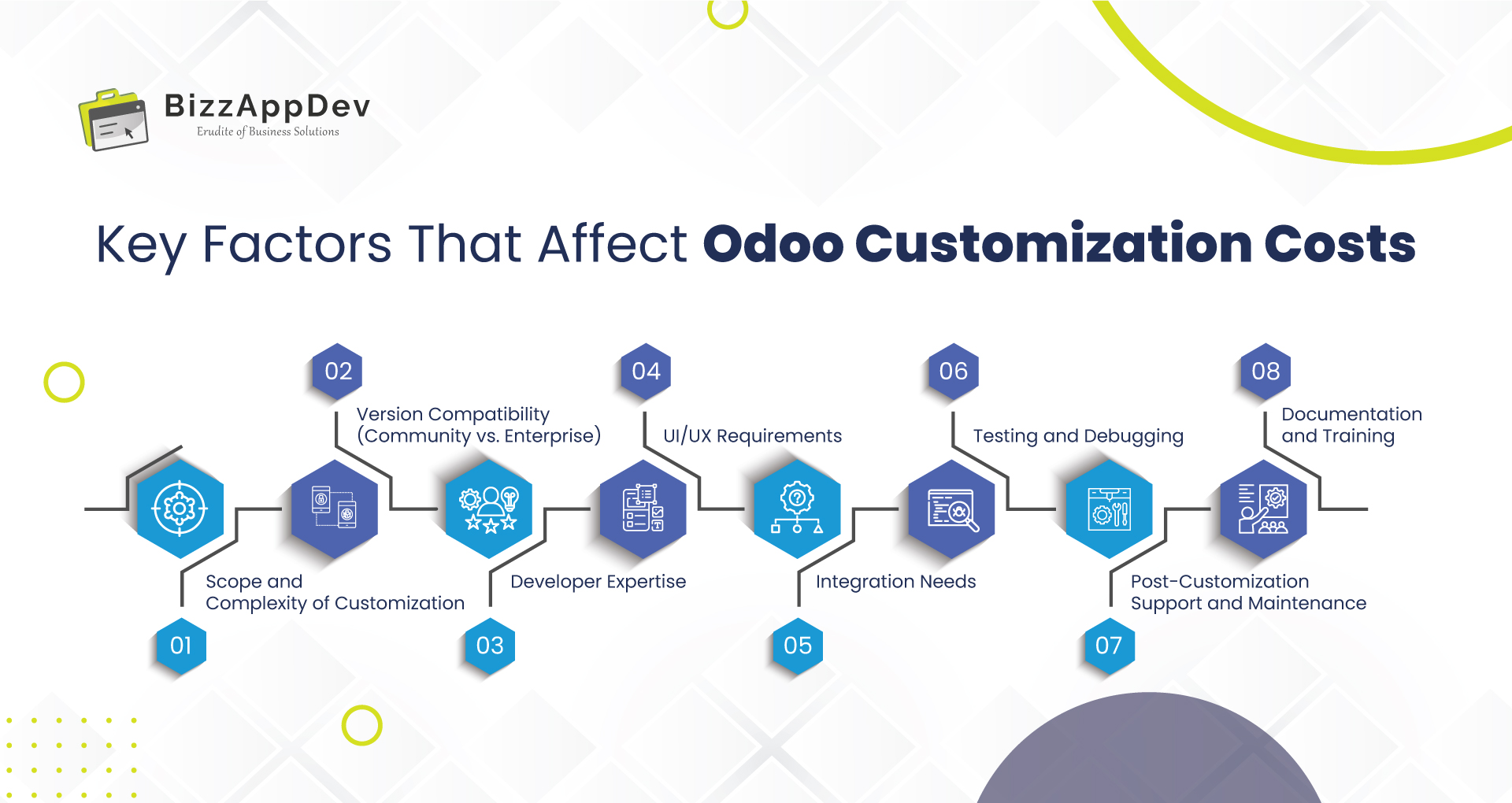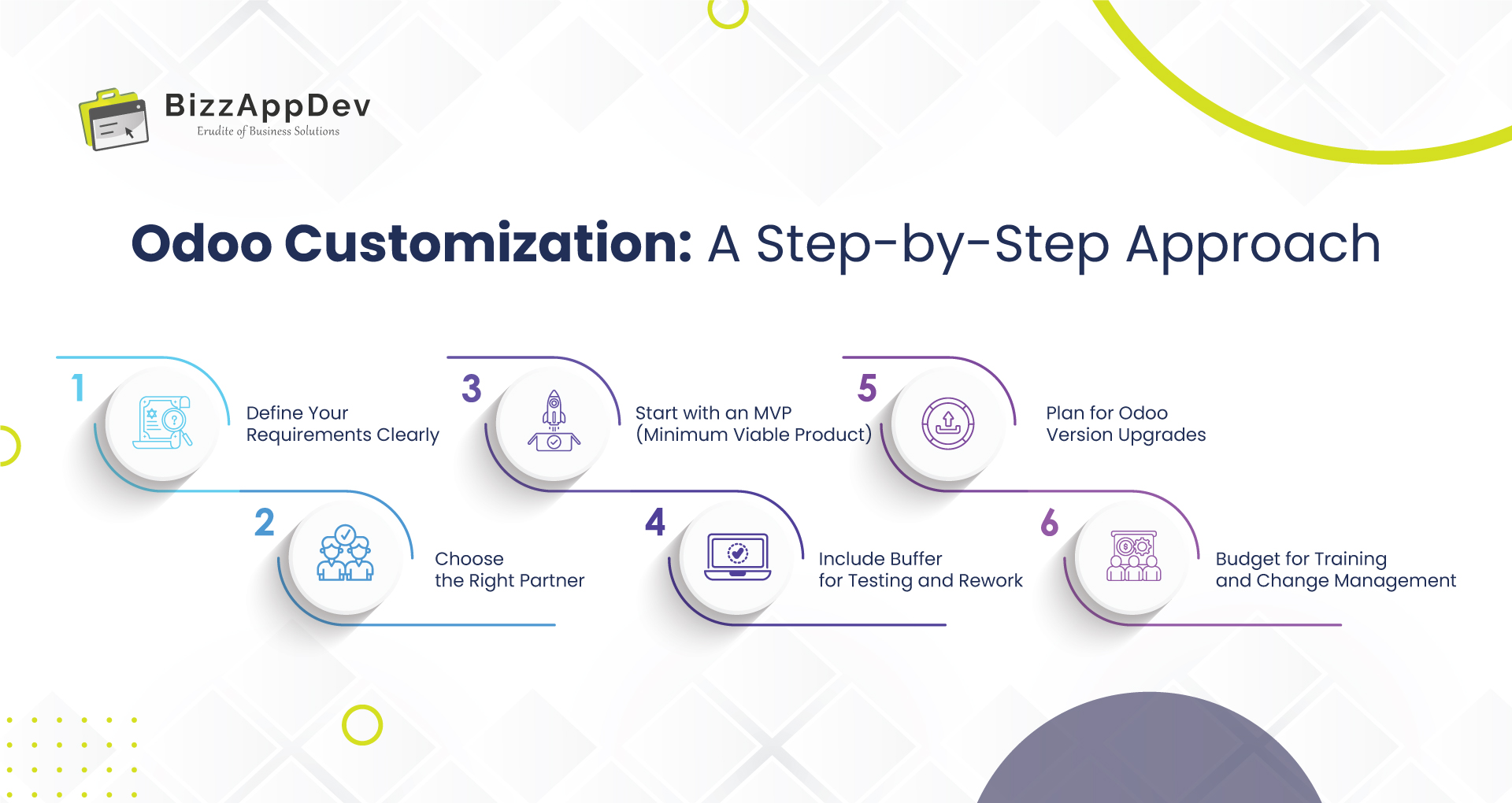Introduction
Investing in the right ERP system isn’t just a technical decision, it’s a strategic one. A well-implemented ERP like Odoo can boost productivity, improve decision-making, and streamline operations across departments. But no two businesses run the same way, and a one-size-fits-all solution often falls short. That’s where Odoo customization comes in.
With its modular and open-source architecture, Odoo allows businesses to tailor functionalities according to their unique workflows, goals, and challenges. From customizing reports and forms to building entirely new modules, the possibilities are vast, but so are the variables that affect cost.
How much does it cost to customize Odoo? The answer isn’t simple. Customization can range from a few hundred to tens of thousands of dollars, depending on the complexity, scope, and execution strategy.
In this comprehensive guide, we’ll break down what goes into Odoo ERP customization costs, how to plan for them, and strategies to budget smartly without compromising on quality or scalability.
What Is Odoo ERP Customization?
Odoo customization refers to modifying existing modules or creating new ones to align the ERP system with your business needs. This includes:
- Tweaking forms, workflows, or dashboards
- Adding custom fields or reports
- Developing custom modules for niche operations
- Integrating with third-party tools
- Enhancing UI/UX for better usability
Unlike standard Odoo implementation, which involves using ready-made modules, customization ensures the ERP feels like it was built for your business, by your business.
Why Customize Odoo?
Every business has unique processes. What works for one company may be a bottleneck for another. Here’s why companies opt for customization:
- Process Alignment: Custom features help align Odoo with existing business processes.
- User Experience: Tailored interfaces boost productivity and ease of use.
- Competitive Advantage: Unique workflows or tools can give your business an edge.
- Scalability: Customize now, scale later, without overhauling the entire system.
- Compliance & Localization: Meet industry regulations or local tax/reporting requirements.
But the power of customization comes with a price tag. Understanding the factors that influence this cost is crucial for a smooth financial journey.
Key Factors That Affect Odoo Customization Costs

Here are the most significant elements that influence how much you’ll spend customizing your Odoo ERP:
1. Scope and Complexity of Customization
The broader and more intricate your requirements, the higher the cost. For example:
- Adding a custom field to a form may take 1–2 hours.
- Developing a fully custom supply chain module may take weeks.
Complex workflows, advanced automation, and deep-level customization require more development, testing, and debugging, leading to higher costs.
2. Version Compatibility (Community vs. Enterprise)
- Odoo Community (free) provides limited modules out of the box.
- Odoo Enterprise (paid) includes advanced functionalities like Studio and a better UI.
Customizing Community often requires developing modules from scratch, whereas Enterprise may reduce development time through built-in tools.
Enterprise may cost more in licensing, but it saves on customization time.
3. Developer Expertise
Customization quality and therefore cost largely depend on who does it:
- Freelancers: Often more affordable but may lack project management or deep expertise.
- Experienced Odoo Partners: Cost more but bring experience, quality control, and future-proof solutions.
At BizzAppDev Systems, we follow best practices and ensure your customizations are robust, upgrade-safe, and scalable.
4. UI/UX Requirements
Need a custom user interface with drag-and-drop elements, dynamic dashboards, or mobile responsiveness? UI/UX design adds cost due to frontend development efforts.
5. Integration Needs
Customizing Odoo to work with other software, like payment gateways, eCommerce platforms, or third-party CRMs, adds complexity.
- Simple APIs = low cost
- Legacy systems or no documentation = high cost
6. Testing and Debugging
Every customization must be tested across modules and use cases. The more complex the customization, the more testing is needed to ensure stability and avoid system conflicts.
Budgeting for QA is essential but often overlooked.
7. Post-Customization Support and Maintenance
Custom features can break after an Odoo version upgrade. Ongoing maintenance contracts or support retainers are necessary to keep things running smoothly.
8. Documentation and Training
Well-documented code and user manuals help onboard your team and reduce long-term dependency on developers.
Skipping this step may save money now, but can cost more down the line.
Budgeting for Odoo Customization: A Step-by-Step Approach

If you want to avoid overspending or last-minute surprises during your Odoo ERP customization journey, it’s crucial to plan your budget with care. The good news? It’s not as overwhelming as it sounds. Follow this simple, step-by-step budgeting roadmap tailored just for you:
Step 1: Define Your Requirements Clearly
Start by asking yourself, What exactly do I need to customize in Odoo? And why? The more clarity you have upfront, the fewer roadblocks you'll face later.
Involve your team, especially the people who'll use the system. They often know where the real pain points are.
To structure your ideas better, try using:
- User stories
- Wireframes
- Process flow diagrams
The clearer your vision, the more accurate your customization quote will be.
Step 2: Choose the Right Partner
Your Odoo partner is your co-pilot in this journey. You don’t just need a developer, you need someone who understands your business.
When evaluating partners, look for:
- Official Odoo partner
- Experience in your specific industry
- A portfolio with similar projects
- Honest client testimonials
At BizzAppDev Systems, we work with you to refine your customization ideas, guide you through smart alternatives, and always keep your budget in mind.
Step 3: Start with an MVP (Minimum Viable Product)
You might be tempted to build everything at once, but hold off. A smarter move? Launch with an MVP.
Start with only the must-have features, go live, gather feedback, and then decide what to improve or add. This way:
- You cut initial costs
- You reduce the risk of building unnecessary features
- You deliver faster results to your team
Step 4: Include Buffer for Testing and Rework
Even the best plans need wiggle room.
Always include an extra budget (typically 20–30%) for:
- Functional testing
- Bug fixes
- Minor adjustments based on real-time feedback
This buffer helps you stay calm and prepared when small issues pop up.
Step 5: Plan for Odoo Version Upgrades
Many businesses overlook this and regret it later.
When Odoo releases a new version, poorly written custom modules often break. To avoid future headaches, make sure your developers:
- Write modular, maintainable code
- Use standard Odoo APIs
- Provide documentation for your custom features
Think of it as future-proofing your investment.
Step 6: Budget for Training and Change Management
Customization is only successful if your team actually uses it. Make space in your budget for:
- Team training sessions
- Easy-to-follow user manuals
- Onboarding guides for new employees
It’s not just about the software, it’s about people confidently using the system to do better work.
Cost-Saving Tips Without Compromising Quality
Let’s face it, custom development can get expensive. But here’s the thing: you don’t have to burn a hole in your pocket to get a powerful, tailor-made Odoo system. Here are some clever ways to save costs while keeping quality intact:
Reuse existing modules:
Before building a feature from scratch, ask your partner if there’s an existing module that can be slightly tweaked to meet your needs. Often, Odoo or its massive community already has what you’re looking for, and that means huge savings for you.
Prioritize features:
Not all features are created equal. Instead of trying to customize everything, focus on the features that bring the highest business value.
Ask yourself:
- Will this feature save me time or money?
- Will it improve my customer experience?
- Is it something my team uses daily?
Prioritize these. The rest can wait.
Automate Only When It’s Worth It:
Automation is amazing, but only when it makes sense. Don’t automate rarely-used processes or workflows that don’t need speed or precision. Keep it simple where it works, and automate where it counts.
Choose a phased implementation:
Rather than paying for everything upfront, consider rolling out your customizations in phases. Start with core modules, go live, and then gradually expand. It’s easier on your budget, and it helps your team adapt more smoothly.
Leverage community resources:
The Odoo community is full of ready-to-use, open-source modules that can reduce development time drastically. Before investing in custom code, ask your Odoo partner to explore community apps. You might just find what you need, without the hefty price tag.
Final Thoughts
Customizing Odoo ERP is an investment, but when done right, it yields high returns in productivity, efficiency, and scalability. Understanding the cost drivers, planning strategically, and choosing the right partner can make the difference between a smart investment and a costly mistake.
Whether you're a startup refining workflows or an enterprise seeking a competitive edge, customization gives Odoo the power to work exactly the way your business does.
Why Choose BizzAppDev Systems?
At BizzAppDev Systems, we specialize in custom Odoo solutions tailored to your business goals. With deep technical expertise, a proven track record, and a passion for excellence, we help businesses like yours implement custom features that work today and scale tomorrow.
Need a personalized quote for your Odoo customization project?
Get in touch with our team today for a free consultation.
Related Blogs